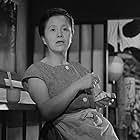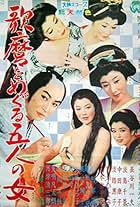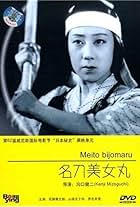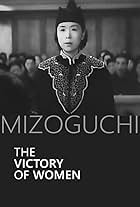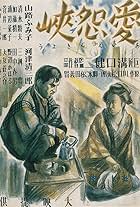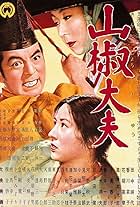The tragic tale of a woman who despite doing good where she can gets punished by society.The tragic tale of a woman who despite doing good where she can gets punished by society.The tragic tale of a woman who despite doing good where she can gets punished by society.
Storyline
Did you know
- Alternate versionsOriginally filmed as a silent movie with Japanese intertitles; an unceasing voiceover narration in Japanese has been added later.
- ConnectionsReferenced in Kenji Mizoguchi: The Life of a Film Director (1975)
Featured review
This has been called The Water Magician. My long forgotten Japanese makes me wish the title words Taki no shiraito might contain something like waterfall's white threads, though Taki is also, I think, stage name of the magician protagonist. Anyway, shiroi = white in my memory, and taki at least sometimes means waterfall. Without knowing the character in the film's titles, ito is at least a homonym for thread or, differently, intention. But I'm grabbing too "water" from the English title, so my whole notion may bunk.
The film is about kindhearted intentions unraveling disastrously (why I wanted thread). Spray fractalling. Foam on rocks. I'd seen all Mizoguchi's sound films, and two or three silents, conceivably even an unrestored print of this one, but last night with live benshi narration and mercifully little music it came alive as few Japanese silents have for me before. One thing to watch for in any Mizoguchi, silent or sound, but no less evident here than in the later work, is his continual reshaping, from within, of the standard 4:3 screen. Everyone knows later Japanese would become masters of scope.By continually repositioning, reframing, shifting focus depth, Mizoguchi does all they've done, if not more, as if the moderns' squashed frame limits rather than frees. One shot may have Taki a splinter against one full vertical edge. In another she'll be a layer between two other characters' layers, each a different distance from the lens, all moving perhaps independently, even if all three together occupy no more than three feet of depth. Shots from slightly overhead end some sections. In the latter third there's a shot of the coach driver, now an official of the magistrate, seated at a table with Taki, he on our right and she center-screen. It's a round table. Despite the seriousness of the occasion, the line of the table curves gently toward Taki. A rectangular table, a dark-against-pale-wall right-angle table corner right there, even with nothing, not a line of dialog or an expression, changed, would have made it a different scene. Early on we usually see Taki dressed for her act, heavily made up. She nearly always shares the screen, seldom fills it. She's first a burden to the serious-minded coach driver, so her approaches to him look coquettish. It's far from obvious that she's to be our hero. Films have been named for femmes fatales. Increasingly toward the end, her face fills the screen, the very features of her face seem to blossom. It turns into a peasant's face, exhausted but proud, at harvest time in a good year. Her whole being waxes before our eyes. The benshi, Midori Sawato, admitted, in Q and A, to having once thought the film was tragic, Taki ending in failure. But Sawato's present take on it, that Taki's heroic, is obvious in Mizoguchi's framings.
Another small note from the Q and A: the more confusing of two deaths in the film is from choking on a bit-off tongue. And finally, though I admitted above to that tiny bit of Japanese, it's little more than enough to know usually where sentences begin and end, where the parts of speech and proper names are but with nearly no vocabulary. You don't need to know the language to appreciate a benshi. If you get the chance, go see.
The film is about kindhearted intentions unraveling disastrously (why I wanted thread). Spray fractalling. Foam on rocks. I'd seen all Mizoguchi's sound films, and two or three silents, conceivably even an unrestored print of this one, but last night with live benshi narration and mercifully little music it came alive as few Japanese silents have for me before. One thing to watch for in any Mizoguchi, silent or sound, but no less evident here than in the later work, is his continual reshaping, from within, of the standard 4:3 screen. Everyone knows later Japanese would become masters of scope.By continually repositioning, reframing, shifting focus depth, Mizoguchi does all they've done, if not more, as if the moderns' squashed frame limits rather than frees. One shot may have Taki a splinter against one full vertical edge. In another she'll be a layer between two other characters' layers, each a different distance from the lens, all moving perhaps independently, even if all three together occupy no more than three feet of depth. Shots from slightly overhead end some sections. In the latter third there's a shot of the coach driver, now an official of the magistrate, seated at a table with Taki, he on our right and she center-screen. It's a round table. Despite the seriousness of the occasion, the line of the table curves gently toward Taki. A rectangular table, a dark-against-pale-wall right-angle table corner right there, even with nothing, not a line of dialog or an expression, changed, would have made it a different scene. Early on we usually see Taki dressed for her act, heavily made up. She nearly always shares the screen, seldom fills it. She's first a burden to the serious-minded coach driver, so her approaches to him look coquettish. It's far from obvious that she's to be our hero. Films have been named for femmes fatales. Increasingly toward the end, her face fills the screen, the very features of her face seem to blossom. It turns into a peasant's face, exhausted but proud, at harvest time in a good year. Her whole being waxes before our eyes. The benshi, Midori Sawato, admitted, in Q and A, to having once thought the film was tragic, Taki ending in failure. But Sawato's present take on it, that Taki's heroic, is obvious in Mizoguchi's framings.
Another small note from the Q and A: the more confusing of two deaths in the film is from choking on a bit-off tongue. And finally, though I admitted above to that tiny bit of Japanese, it's little more than enough to know usually where sentences begin and end, where the parts of speech and proper names are but with nearly no vocabulary. You don't need to know the language to appreciate a benshi. If you get the chance, go see.
- frankgaipa
- Sep 13, 2002
- Permalink
Details
- Release date
- Country of origin
- Languages
- Also known as
- El hilo blanco de la catarata
- Production companies
- See more company credits at IMDbPro
- Runtime1 hour 50 minutes
- Color
- Sound mix
- Aspect ratio
- 1.37 : 1
Contribute to this page
Suggest an edit or add missing content










